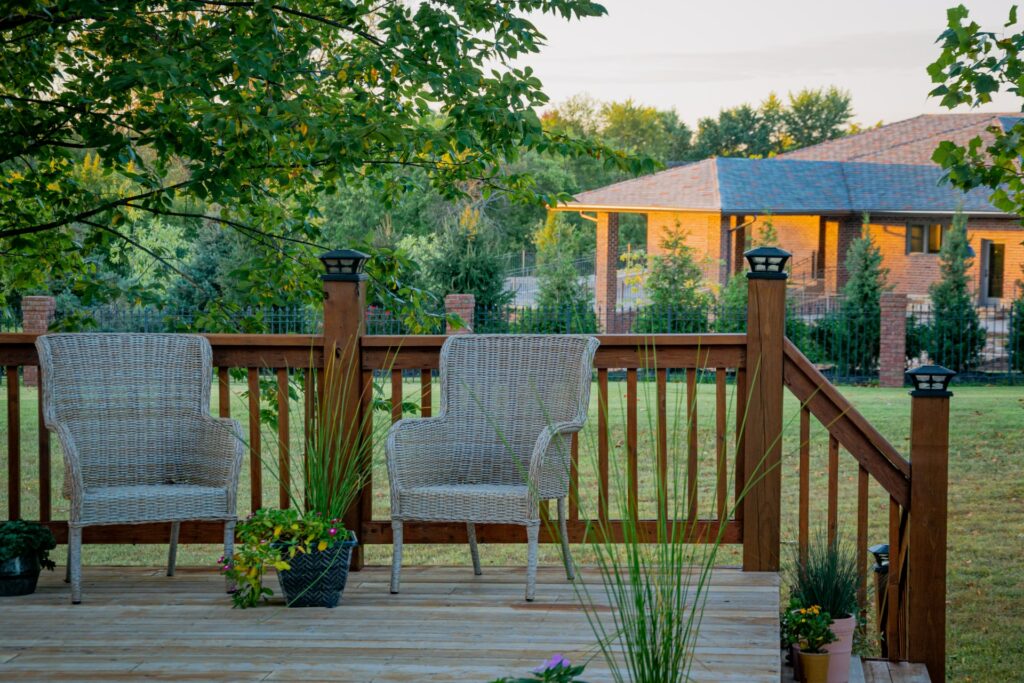
Most of us are familiar with the damage that freezing cold weather can do to our pipes, or what our roof could look like after the remnants of a tropical storm with violent winds blows through. But those are not the only extreme weather conditions that can wreak havoc on our homes. Here in the south, we’re quite used to long, hot summers, where the heat index flirts with triple digits and the humidity will have you running back in to the comfort of air conditioning and a cool drink. We aren’t the only ones who feel the effects of the excessive summer heat though. These temperatures can also have quite an impact on your house, potentially causing damage to aspects of both the interior and exterior features of your home. Here are a few specific parts of your home that hot weather can damage, and what you can do to lessen or altogether prevent these problems.
How Heat Affects Hardwood Flooring

Any type of wood can warp in high heat and humidity, and the slats that make up your hardwood flooring are no different. Both heat and humidity can cause wood to expand, and as the slats push against each other, your floor can become uneven. Floors can even buckle, which means that the slats can potentially pull up and away from the subfloor completely.
While this sounds like a major problem, it is possible that as the wood dries out, the floor may return to its original condition. If you are able to remedy a high humidity situation in your home quickly, you may not need to intervene at all. If on the other hand the humidity remains high for an extended period of time, cracks can occur in the wood causing permanent damage.
The best way to prevent this issue is to be diligent in controlling the amount of humidity in your home. For homes with hardwood flooring, the ideal humidity level is between 35% and 55%. To achieve this, you may need to run your air conditioning at a lower temperature than you might choose for conserving energy, particularly on very hot days or on those when the humidity levels are extra high. If you cannot achieve lower humidity levels simply by lowering your thermostat, you might want to consider investing in a whole home dehumidifier.
How Your Foundation Can Suffer in the Summer

This time of year you will often hear people say “it’s not the heat, it’s the humidity.” That’s true for a lot of what we are discussing here, but while the moisture in the air may wreak havoc on your hair, the hotter months also bring about trouble due to the dryness. Of particular concern is the danger faced by your home’s foundation due to the drying nature of heat. When homes are built, their foundations are designed to use the surrounding soil as an ongoing support system. When the ground around your foundation heats up during the hot summer months, the surrounding soil shrinks, and the moisture contained in the soil evaporates. This causes the soil to separate from your home’s footing, potentially damaging your foundation.
So what can you do? There are actually multiple things you can do to help your foundation with this issue. Start by keeping the moisture content of the soil around your foundation high enough, which can usually be accomplished by running your sprinkler system, keeping in mind that you may be limited in the days and times you can use outdoor watering if North Georgia experiences a true drought. Another way to control the moisture content of the soil around your house is to remove any large trees located close to the house. Trees draw in a lot off the moisture from the soil around your home. Water seeking roots can create drought like conditions in the surrounding soil, long before an official drought has been declared in your area.
Possible Damage to Your Roof

Perhaps the part of your home that is the most vulnerable to the extreme heat of the sun is the roof. These days when houses are built, the attics often do not include great airflow, and therefore they tend to be the hottest part of the house. The high humidity we experience in North Georgia during the summer only adds to the issue, as moisture builds up in your attic. When you combine this excess heat and moisture, it can cause your roof’s shingles to deteriorate much faster than they should.
Another negative effect of high temperatures on your roof comes in the form of cracked shingles. Heat can cause your roof to expand and warp, eventually cracking them and making it far more likely that your roof will leak. The summer sun can also dry out the caulk around flashing, which over time will weaken your roof structurally. Luckily all of this heat damage can be prevented by properly maintaining your ductwork, and by installing vapor barriers to decrease moisture. When you do get your roof replaced, make sure that the roofing company coats and seals the roof to protect against harmful UV rays. You can also do yourself a favor by choosing a lighter color for the your shingles if you are in the process of building a home or if you need to replace your roof, and by scheduling regular maintenance checks so that a roofing professional can check for any damage before it becomes severe.
Burst Pipes Aren’t Just a Winter Concern
You might think that only cold weather poses a problem for pipes, but the hot summers in Georgia can also put your home’s pipes at risk. Water usage often increases during the summer, and if pipes are not sealed correctly it is possible this increase in use could cause pipes to leak or even burst. Pipes that previously seemed fine may not be able to handle the stress that comes from filling swimming pools, frequent use of the garden hoses, and running your automatic sprinklers when added to your regular daily usage. Your pipes may also be in danger after a long stretch of hot weather with no rain. When the soil around your home gets excessively dry, it can cause shifts in and around your home’s foundation. Dry weather can also cause water lines to disconnect or rupture, and can result in cracks and leaks in water mains.
To prevent these issues, have a plumber check the caulking and sealing around your pipes, and have then reseal as needed. Protect your home’s foundation and the surrounding water lines during dry months by making sure that the soil surrounding your home is kept moist, by setting your automatic sprinklers or manually watering.
Your Deck Isn’t Safe in the Sun

We’ve already mentioned the affect heat and moisture can have on your hardwood flooring, but you likely have many other wood features around your home. If your home has one or more wooden decks or balconies, the excessive heat and sun can dry them out and cause damage. The most common complaint people have about the summer weather and these wood features is that the wood becomes discolored over time, and any protective weatherizing coating can also become discolored and begin to crack and peel. If you find that you need to restain your deck to fix these heat related issues, look for a protective coating product and be sure to strip the current layer thoroughly before reapplying.
Problems with Siding in the Sun

Siding on your home can warp in hot temperatures, and the degree to which it will warp often depends on what material it’s made of. For example, wood siding is particularly bad about warping and bending in the summer heat due to its moisture content. In recent years, siding has been more commonly made of more resilient materials that rarely show any effects from the summer sun. But if your house is older with older siding, it is likely still made of more vulnerable wood. Non-wood materials can occasionally warp in extreme temperatures. When siding warps, it no longer provides a good protective seal against moisture and pests that can potentially get into your home.
What Heat Can do to Your Paint
Excessive heat can lead to paint damage on your home’s exterior, especially if you do not have shade trees blocking any of the sun’s rays. Damaged paint will be obvious to the naked eye – look for places where the paint is bubbling, chipping or flaking. Or if the damage is mild you may simply find that your paint color as faded. However if the damage is severe, this can lead to openings that can potentially allow moisture into your home. This can eventually cause a mold issue. You can avoid these issues by choosing a more heat and humidity resistant type of paint when you next have your exterior painted. Instead of the usual paint you would use on the outside of your home, look for elastomeric paint instead, which creates a barrier against invasive summer moisture.

